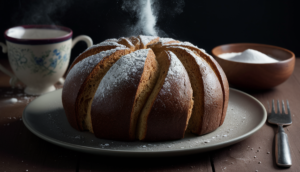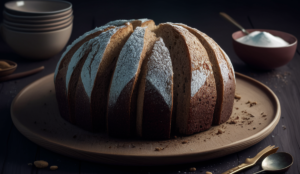Introduction: The Role of Baking Soda in Bread Making
Baking soda, known as sodium bicarbonate, acts as a crucial leavening agent in various bread recipes. It plays a significant role, especially in quick breads like banana bread, soda bread, and muffins. Leavening agents, such as baking soda, are essential because they enable the dough to rise. The release of carbon dioxide, triggered by the combination of baking soda with an acidic component like lemon juice or buttermilk, helps create a soft and airy texture in bread.
By understanding how baking soda works, you’ll grasp the importance of its role in baking. Without it, the bread could end up dense, flat, and lacking in the desired texture. Let’s take a closer look at what exactly happens when baking soda is omitted from a bread recipe.
The Science Behind Baking Soda
The role of baking soda in bread making may seem straightforward, but it’s crucial to understand its unique properties. Baking soda, or sodium bicarbonate, acts as a chemical leavening agent. When it comes into contact with an acidic ingredient—such as lemon juice, vinegar, or buttermilk—a reaction occurs. This reaction releases carbon dioxide gas, which forms bubbles that expand during the baking process. As the gas expands, it creates the rise in dough, resulting in the soft, fluffy texture characteristic of many baked goods.
Baking soda works immediately upon activation, making it essential to bake the dough or batter right after mixing. Any delay could cause the gas to escape before baking, leading to a denser final product. Unlike baking powder, which generates gas in two stages (once when mixed with liquid and again when exposed to heat), baking soda only produces gas during its initial interaction with acid. This makes it highly effective in recipes that require a quick rise, such as muffins, pancakes, and other quick breads.
The Effects of Leaving Out Baking Soda
If you accidentally skip baking soda in your bread recipe, the results may vary. Here are some key factors that could be affected:
1. Bread Structure
Bread’s structure depends largely on leavening agents. When you omit baking soda, the dough won’t rise as much, resulting in a denser, more compact loaf. Because there is no release of carbon dioxide, the bread remains flat, which is especially noticeable in quick breads. Yeast breads, on the other hand, may still rise a bit due to yeast fermentation, but the texture will feel heavier and denser.
2. Texture and Crumb
The omission of baking soda tightens the crumb of the bread, making it denser and more compact. With fewer air pockets forming inside the dough, the bread loses the light, airy quality typically associated with properly leavened bread. This denser texture might make the bread feel heavy, and it can also alter how the bread retains moisture.
3. Flavor Profile
The absence of baking soda can impact the bread’s flavor. As an alkaline ingredient, baking soda neutralizes some of the acidity in a recipe. Without it, the bread could take on a slightly tangier taste, especially if the recipe calls for acidic components like yogurt or buttermilk. Although this tanginess can complement certain recipes, it may clash with others. Baking soda also promotes browning, which deepens the flavor and adds a richer crust. Without it, the bread could turn out lighter in both color and flavor.
4. Moisture Content
Baking soda indirectly influences moisture retention. During the chemical reaction with acid, steam is generated, which adds moisture to the bread. Without this reaction, the bread may be drier than expected. However, small adjustments in liquid ingredients can usually counteract this effect.
5. Appearance
Bread without baking soda often looks different. The dough won’t rise as much, which leaves you with a flatter, squatter loaf. Additionally, the lack of browning agents can result in a paler crust, giving the bread an undercooked appearance, even when it’s baked through.
How to Compensate for the Lack of Baking

If you run out of baking soda or avoid it for dietary reasons, don’t worry. You can try these substitutes and adjustments to keep your bread from falling flat:
1. Use Baking Powder Instead
Baking powder contains both baking soda and an acid, so it can replace baking soda in most recipes. To achieve the same leavening effect, you’ll need about three times the amount of baking powder. For example, one teaspoon of baking soda would be replaced by three teaspoons of baking powder. However, be cautious, as baking powder could alter the taste slightly.
2. Increase Acidic Ingredients
Incorporating more acidic ingredients, such as buttermilk, lemon juice, or yogurt, can enhance the leavening process even without baking soda. Although it won’t completely compensate for the lack of baking soda, it can help introduce some lift and improve the texture.
3. Whipped Egg Whites
Whipping egg whites and folding them into your dough or batter adds air to the mix, providing some additional lift. This technique works well for quick breads and cakes, where a lighter texture is desired.
4. Use Yeast
Yeast can be a viable substitute when you need extra lift. Yeast ferments sugars in the dough, releasing carbon dioxide that helps the bread rise. Just be aware that this method takes more time and requires longer proofing periods than baking soda.
FAQs About Bread Without Baking

Cultural Variations and Traditions
Across various cultures, traditional breads often avoid the use of baking soda or any chemical leavening agents altogether. For instance, flatbreads like tortillas from Latin America and pita from the Middle East have been staples for centuries without the need for leavening. These breads rely on simple ingredients such as flour, water, and salt. Instead of leavening agents, the dough is kneaded and rolled to create a consistent texture.
In Jewish culture, matzo is a prime example of unleavened bread. This flatbread is specifically made without leavening to honor the Passover tradition. Matzo’s crisp texture is achieved through rolling the dough very thin and baking it at high temperatures.
These breads demonstrate that while leavening agents like baking soda can enhance the rise and texture of bread, they are not always necessary. Different techniques—such as stretching, kneading, or flattening—can be used to create delicious and satisfying breads without relying on the chemical reactions triggered by leavening agents.
Conclusion: Is Baking Soda Essential?
In summary, baking soda plays a critical role in bread baking by contributing to texture, rise, and flavor. Without it, bread tends to be denser, more compact, and lacking in the usual lift. That said, alternative methods and ingredients can still produce a tasty loaf. Whether using baking powder, yeast, or egg whites, understanding the science behind leavening will help you adjust your recipes accordingly.
Baking is a balance of art and science, and experimenting with different ingredients allows you to discover new ways to create delicious bread. Although baking soda is a powerful tool, its absence doesn’t mean you can’t bake a beautiful loaf.

